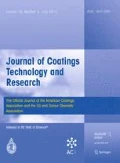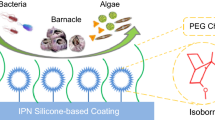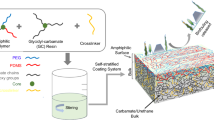Abstract
Poly(ethylene glycol) (PEG) is a hydrophilic polymer that has been extensively used in the biomedical and marine environment due to its antifouling properties. In the biomedical field, PEG has been successfully used to functionalize surfaces due to its resistance to cell and nonspecific protein adsorption. However, the long-term stability of PEG has limited its use in some areas. In the shipping industry, there is a great need for long-term solutions to keep the hulls of the ships fouling-free. The long-term stability of PEG in polydimethylsiloxane (PDMS) fouling-release coatings is studied here, in both accelerated laboratory tests and real seawater conditions. This article shows how PEG-based copolymers, which have been exposed in fouling-release coatings to real-life seawater conditions, are isolated and compared to those exposed to accelerated laboratory testing with successful results. The influence of the chemistry of the PEG compounds, the chosen laboratory degrading agents, and the possible degradation pathways and products are discussed.








Similar content being viewed by others
References
Messeguer Yebra, D, Kiil, D, Dam-Johansen, K, “Antifouling Technology—Past, Present and Future Steps Towards Efficient and Environmentally Friendly Antifouling Coatings.” Prog. Org. Coat., 50 75–104 (2004)
Callow, JA, Callow, ME, “Trends in the Development of Environmentally Friendly Fouling-Resistant Marine Coatings.” Nat. Commun., 2 (244) 1–10 (2011)
Chen, S, Li, L, Zhao, C, Zheng, J, “Surface Hydration: Principles and Applications Toward Low-Fouling/Nonfouling Biomaterials.” Polymer, 51 5283–5293 (2010)
Demirel, YK, Khorasanchi, M, Turan, O, Incecik, A, “On the Importance of Antifouling Coatings Regarding Ship Resistance and Powering.” Proc. Low Carbon Shipping, London 2013
Schultz, MP, “Effects of Coating Roughness and Biofouling on Ship Resistance and Powering.” Biofouling, 23 (5) 331–341 (2007)
Bodkhe, RB, Stafslien, SJ, Cilz, N, Daniels, J, Thompson, SEM, Callow, ME, Callow, JA, Webster, DC, “Polyurethanes with Amphiphilic Surfaces Made Using Telechelic Functional PDMS Having Orthogonal Acid Functional Groups.” Prog. Org. Coat., 75 38–48 (2012)
Bodkhe, RB, Stafslien, SJ, Daniels, J, Cilz, N, Muelhberg, AJ, Thompson, SEM, Callow, ME, Callow, JA, Webster, DC, “Zwitterionic Siloxane-Polyurethane Fouling-Release Coatings.” Prog. Org. Coat., 78 269–380 (2015)
Kavanagh, CJ, Swain, GW, Kovach, BS, Stein, J, Darkangelo-Wood, C, Truby, K, Holm, E, Motemarano, J, Meyer, A, Wiebe, D, “The Effects of Silicone Fluid Additives and Silicone Elastomer Matrices on Barnacle Adhesion Strength.” Biofouling, 19 (6) 381–390 (2003)
Ostuni, E, Chapman, RG, Holmin, RE, Takayama, S, Whitesides, GM, “A Survey of Structure-Property Relationships of Surfaces that Resist the Adsorption of Protein.” Langmuir, 17 5605–5620 (2001)
Ekblad, T, Hydrogel Coatings for Biomedical and Biofouling Applications. Linköping University, Linköping, 2010.
Li, L, Chen, S, Zheng, J, Ratner, BD, Jiang, S, “Protein Adsorption on Oligo(ethylene glycol)-Terminated Alkanethiolate Self-Assembled Monolayers: The Molecular Basis for Nonfouling Behavior.” J. Phys. Chem., 109 2934–2941 (2005)
Thorlaksen, PCW, Blom, A, Bork, U, “Novel Fouling Control Coating Compositions.” WO Patent 076856A1, 2011
Thorlaksen, PCW, “Fouling Control Coating Compositions Comprising Polysiloxane and Pendant Hydrophilic Oligomer/Polymer Moieties.” WO Patent 076856A1, 2011
Webster, DC, Bodkhe, RB, “Functionalized Silicones with Polyalkylene Oxide Side Chains.” WO Patent 052181A2, 2013
Reynolds, KJ, Tyson, BV, “Anti-Fouling Compositions with a Fluorinated Oxyalkylene-Containing Polymer or Oligomer.” WO Patent 131695A1, 2014
Stein, J, Burnell, TB, Cella, JA, “Condensation Curable Silicone Foul Release Coatings and Articles Coated Therewith.” US Patent 6,107,381, 2000
Tanino, S, “Antifouling Coating Composition, Antifouling Coating Film, Antifouling Substrate, and Method for Improving Storage Stability of Antifouling Coating Composition.” European Patent 2,921,538A1, 2015
Liao, WP, “Antifouling System Comprising Silicone Hydrogel.” WO Patent 126643A1, 2014
Nurioglu, AG, Esteves, ACA, de With, G, “Non-Toxic, Non-Biocide-Release Antifouling Coatings Based on Molecular Structure Design for Marine Applications.” J. Mater. Chem. B, 3 6547–6570 (2015)
Kober, M, Wesslén, B, “Surface Properties of a Segmented Polyurethane Containing Amhiphilic Polymers as Additives.” J. Appl. Polym. Sci., 54 793–803 (1994)
Murthy, R, Cox, CD, Hahn, MS, Grunlan, MA, “Protein-Resistant Silicones: Incorporation of Poly(Ethylene Oxide) via Siloxane Tethers.” Biomacromolecules, 8 3244–3252 (2007)
Lee, JH, Lee, HB, Andrade, JD, “Blood Compatibility of Polyethylene Oxide Surfaces.” Prog. Polym. Sci., 20 1043–1079 (1995)
Zhang, H, Chiao, M, “Anti-fouling Coatings of Poly(dimethyl siloxane) Devices for Biological and Biomedical Applications.” J. Med. Biol. Eng., 35 143–155 (2015)
Kawai, F, “Microbial Degradation of Polyethers.” Appl. Microbiol. Biotechnol., 58 30–38 (2002)
Han, S, Kim, C, Kwon, D, “Thermal/Oxidative Degradation and Stabilization of Polyethylene Glycol.” Polymer, 38 (2) 317–323 (1997)
Haines, JR, Alexander, M, “Microbial Degradation of Polyethylene Glycols.” Appl. Microbiol., 29 (5) 621–625 (1975)
Bernhard, M, Eubeler, JP, Zok, S, Knepper, TP, “Aerobic Biodegradation of Polyethylene Glycols of Different Molecular Weights in Wastewater and Seawater.” Water Res., 42 4791–4801 (2008)
Morlat, S, Gardette, JL, “Phototransformation of Water-Soluble Polymers. I: Photo- and Thermooxidaion of Poly(ethylene oxide) in Solid State.” Polymer, 42 6071–6079 (2001)
Yang, L, Heatley, F, Blease, TG, Thompson, RIG, “A Study of the Mechanism of the Oxidative Thermal Degradation of Poly(ethylene oxide) and Poly(propylene oxide) Using 1H- and 13C-NMR.” Eur. Polym. J., 32 (5) 535–547 (1996)
Mkhatresh, OA, Heatley, F, “A 13C NMR Study of the Products and Mechanism of the Thermal Oxidative Degradation of Poly(ethylene oxide).” Macromol. Chem. Phys., 203 2273–2280 (2002)
Hassouna, F, Morlat-Thérias, S, Mailhot, G, Gardette, JL, “Influence of Water on the Photodegradation of Poly(ethylene oxide).” Polym. Degrad. Stab., 92 2042–2050 (2007)
Morlat, S, Gardette, JL, “Phototransformation of Water-soluble Polymers. Part II: Photooxidation of Poly(ethylene oxide) in Aqueous Solution.” Polymer, 44 7891–7897 (2003)
Milne, A, “Anti-Fouling Marine Compositions.” US Patent 4,025,693, 1977
Wu, Z, Hjort, K, “Surface Modification of PDMS by Gradient-Induced Migration of Embedded Pluronic.” Lab Chip, 9 1500–1503 (2009)
Li, JT, Caldwell, KD, Rapoport, N, “Surface Properties of Pluronic-Coated Polymeric Colloids.” Langmuir, 10 4475–4482 (1994)
De Sainte Claire, P, “Degradation of PEO in the Solid State: A Theoretical Kinetic Model.” Macromolecules, 42 3469–3482 (2009)
Griffiths, PJF, Gughes, JG, Park, GS, “The Autoxidation of Poly(propylene oxide)s.” Eur. Polym. J., 29 (2/3) 437–442 (1993)
Gallet, G, Erlandsson, B, Albertsson, AC, Karlsson, S, “Thermal Oxidation of Poly(ethylene oxide-propylene oxide-ethylene oxide) Triblock Copolymer: Focus on Low Molecular Weight Degradation Products.” Polym. Degrad. Stab., 77 55–66 (2002)
Gauvin, P, Lemaire, J, “Photo-oxydation de Polyéther-bloc-Polyamides, 3 Propriétés des Hydroperoxydes dans les Homopolymères de Polyéthers Correspondants.” Makromol. Chem., 188 1815–1824 (1987)
Barton, Z, Kemp, TJ, Buzy, A, Jennings, KR, “Mass Spectral Characterization of the Thermal Degradation of Poly(propylene oxide) by Electrospray and Matrix-assisted Laser Desorption Ionization.” Polymer, 36 (26) 4927–4933 (1995)
Olsen, SM, Controlled Release of Environmentally Friendly Antifouling Agents from Marine Coatings. Technical University of Denmark, Lyngby, 2009.
Julian, JM, Anderson, DG, Brandau, AH, McGinn, JR, Millon, AM, An infrared Spectroscopy Atlas for the Coatings Industry. Federation of Societies for Coatings Technology. Blue Bell, Pennsylvania, 1991.
Mortensen, MN, Stabilization of Polyethylene Glycol in Archaeological Wood. Technical University of Denmark, Lyngby, 2009.
Acknowledgments
The help of the colleagues in DTU-Chemical and Biochemical Engineering Department and Hempel A/S, as well as the help from DTU-Nanotech and DTU-Chemistry and the financial support of the Danish Ministry for Science and Technology, is gratefully acknowledged.
Author information
Authors and Affiliations
Corresponding author
Additional information
This paper was presented at the 11th Coatings Science International Conference (COSI) on June 22–26, 2015 in Noordwijk, the Netherlands.
Rights and permissions
About this article
Cite this article
Camós Noguer, A., Olsen, S.M., Hvilsted, S. et al. Long-term stability of PEG-based antifouling surfaces in seawater. J Coat Technol Res 13, 567–575 (2016). https://doi.org/10.1007/s11998-016-9801-9
Published:
Issue Date:
DOI: https://doi.org/10.1007/s11998-016-9801-9




